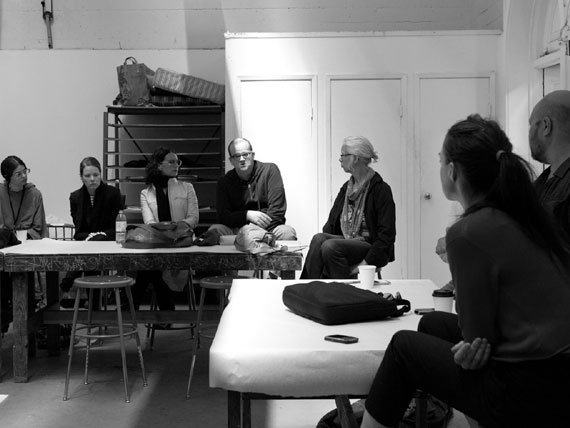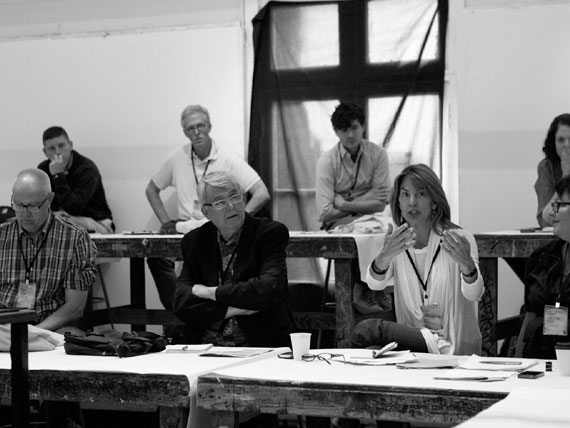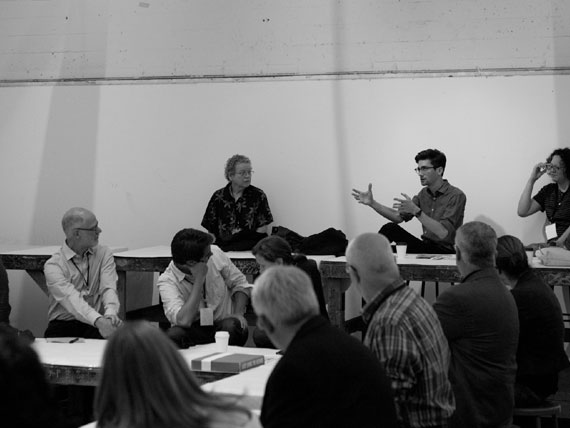Legacy as Currency
This moderated discussion examines how organizations can create value from their institutional histories and how these histories can be effectively communicated internally and externally.
A conversation with Robert Crouch, LACE and Stefan Kalmar, Artists Space moderated by Shana Lutker, X-TRA.
Double-edged histories
Following an introduction by Shana Lutker, Robert Crouch kicked off the panel with a personal story. “When I speak of the legacy of LACE,” he said, “It’s going to sound autobiographical and subjective because my career is an example of the influence LACE had on my generation. When I started art school at the San Francisco Art Institute back in 1991, Los Angeles was not on my radar. In 1992, something happened that caused a huge stir: the exhibition Helter Skelter, curated by Paul Schimmel, of art in Los Angeles in the 1990s. Everyone found this interesting given that it was 1992 and he was making a statement about the decade when it had just begun. People made pilgrimages from San Francisco to Los Angeles to see the show. It was ballsy, polarizing and controversial, and for someone who was twenty-one years old, it was incredibly exciting.
“That was the moment that Los Angeles figured into my career path in a way that it hadn’t before. Should I go to New York or Los Angeles? I chose LA, and my first month there I was in a show at LACE, which meant there was an immediate connection with the artists in Helter Skelter because many of them, like Paul McCarthy, had had an exhibition or meaningful event at LACE early in their career. LACE wasn’t just a place were emerging artists had exhibitions, it was a springboard or catalyst.
“Fast forward to where I am now, an associate curator at LACE. Now I’m grappling with the legacy in a different way, through the expectations placed on me and my colleagues. The history becomes a legitimizing canon that bolsters arguments to funders. It doesn’t do the art we’re working with a service to have that weight of expectation, because the opportunities we offer artists are nothing like the gloss of art stardom. What we’ve been able to use is the experience of experimentation. LACE’s third show, in 1978, had a Mike Kelley performance and audiotapes, neither of which had much business with the market place. I see that as the genesis of LACE’s true legacy.
“Carol Stakenas, our Executive Director, and I often work with artists who were involved in LACE in its heyday, the late 1980s, when the cultural conditions of this country allowed alternative spaces to prosper in a way they can’t really any more. At one point, LACE was the only space in town that addressed the need of artists at a certain point in their career, so it received a lot of support. Now, the funding for a million dollar budget isn’t there. Dealing with our legacy is an impossible project—we’re constantly being compared to a situation that doesn’t exist any more, which creates a unique set of problems along with some advantages. The history does offer some legitimacy to our programs, and to our ability to contribute to the long term development and health of an artist’s career. But part of our legacy is an ideal, something that was made possible by conditions that no longer exist.”
Jettisoning legacy
Crouch’s story sparked a passionate conversation about legacies in which Matthew Higgs of White Columns sided with Stefan Kalmar in making an argument for leaving institutional history to scholars. Kalmar said, “Artists Space was playing at being a big museum. It had a Board Room. It had a big storage area with lots of plinths. It had become a petit bourgeois institution with a big archive. The first thing we did when I came was sell the archive to New York University (NYU). Academics can deal with our history. When an institution gets busy with its own history, it’s fucked. Our institutions were born out of urgency.”
Higgs agreed, saying, “You described the heyday of Lace…the heyday of White Columns is today. If you talk to talk to the artists who worked with the space in the past they don’t romanticize the programs. It probably wasn’t any better then. The most important work done at White Columns is the work that’s being done now. When I arrived in 2004, White Columns was failing artists at every level because the programming had become generic artists space programming: sprawling shows around mediocre themes. I believe that I’m running a new organization that just happens to be called White Columns. My program started in 2005, I just chose not to change the name. The way I run the organization and what we do is completely different.”
Kalmar added, “We are a space for artists. It’s very simple. We don’t need 500 people a day through the door—that changes your way of thinking. We talk about bottom up rather than top down, defining success by the quality of the programs and how we relate to our local context. If it doesn’t work locally it doesn’t work at all.”
A splay-eyed view
Several members of the audience suggested more nuanced views of legacy, with comments ranging from, “We’re thirty-two years old and the way we choose to think about our history is looking splay-eyed, one eye on the future and one on the past” to “We’re a small town gallery. I intend to use the past to fund the future, with a milestone fundraising event to fund the next 10 years,” and “Maybe we’re more centered about it, but I have respect for those that came before us,” to which Kalmar rejoined, “I’m respectful of the community I serve and I don’t know a thing about the Pictures generation. It’s tedious.”
Thomas Lawson, editor of the online journal East of Borneo, tempered the discussion, saying, “I’d like to pick up on what you were saying about shifting the archive to NYU. I’m always interested in the history. I do remember the mid-80s when alternative spaces kept having shows like “Artists return to Artists Space” but history does need to be dealt with. The place for that is in the publications…give us the stuff.”
Following Lawson’s cue, Lutker steered the conversation towards archives, a topic on which almost everyone had something to say. Comments ranged from “We’re in the process of scanning anything in the archive that might be of public interest and putting it on our website. Once we have it scanned we’ll give it away,” to “We had a flood and had to move everything to a warehouse. Now we’re saying we need to bring it back.” One participant remarked that material from his organization’s radical past had persuaded the Board to support experimental programming now, and Carol Stakenas of LACE described an instance of experimental programming from the past—an Allen Kaprow happening—which, when restaged by the artist Steve Roden—became experimental programming in the present. “To this day,” Stakenas said, “The artists involved talk about how life changing that opportunity was. Legacy is not only about organizational development and positioning what you are doing.”
Legacy and money
Higgs pointed out the double meaning of “currency” in the session’s title as the conversation turned to monetizing legacies. “I think artists have a moral obligation to support the organizations that supported them for the rest of their life,” he said. “Our legacy is a fiscal resource. We got a drawing from John Currin that we sold for $45,000. The list of people who have participated is a blueprint of people we can approach.”
An audience member responded that her organization had difficulty getting artists who had achieved a level of renown even to list her venue on their resumes. “How do we reposition ourselves?” she asked.
Kalmar responded, “It’s purely practical. Stay in contact not only when you need something from them. Create a relationship that’s not built on exchange. If you only talk to them every five years when you ask them for a major work they may not be that responsive.”
Higgs agreed, saying, “When I arrived at White Columns, we did a benefit and sent a lifetime membership to everyone who donated work. It was a very simple gesture. Some don’t say thanks, but a lot of them do…It’s vital that we use whatever visibility and access we have to support our people. When I ask an artist to contribute to a benefit and they say no I will never work with them again. They’ve told me something about themselves. We only approach people every five years and I think they have an obligation.”
The conversation turned to the responsibility established alternative spaces have to help younger spaces. As the session neared the end, an audience member brought the conversation back to legacy, saying to Higgs, “If you had come into New York to create an organization that does what you do, it would have been impossible. Turning it around and getting funding was easier because you had that legacy.”







